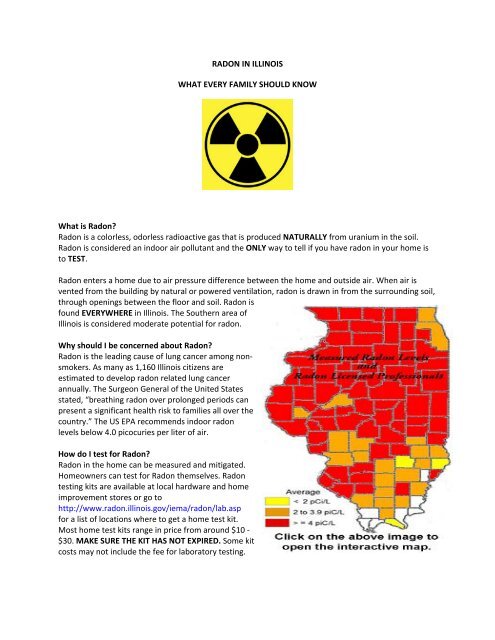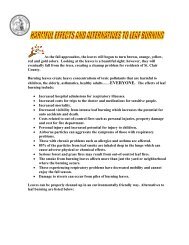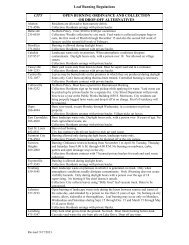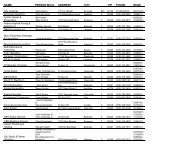FAQ - St. Clair County Health Department
FAQ - St. Clair County Health Department
FAQ - St. Clair County Health Department
You also want an ePaper? Increase the reach of your titles
YUMPU automatically turns print PDFs into web optimized ePapers that Google loves.
RADON IN ILLINOIS<br />
WHAT EVERY FAMILY SHOULD KNOW<br />
What is Radon?<br />
Radon is a colorless, odorless radioactive gas that is produced NATURALLY from uranium in the soil.<br />
Radon is considered an indoor air pollutant and the ONLY way to tell if you have radon in your home is<br />
to TEST.<br />
Radon enters a home due to air pressure difference between the home and outside air. When air is<br />
vented from the building by natural or powered ventilation, radon is drawn in from the surrounding soil,<br />
through openings between the floor and soil. Radon is<br />
found EVERYWHERE in Illinois. The Southern area of<br />
Illinois is considered moderate potential for radon.<br />
Why should I be concerned about Radon?<br />
Radon is the leading cause of lung cancer among nonsmokers.<br />
As many as 1,160 Illinois citizens are<br />
estimated to develop radon related lung cancer<br />
annually. The Surgeon General of the United <strong>St</strong>ates<br />
stated, “breathing radon over prolonged periods can<br />
present a significant health risk to families all over the<br />
country.” The US EPA recommends indoor radon<br />
levels below 4.0 picocuries per liter of air.<br />
How do I test for Radon?<br />
Radon in the home can be measured and mitigated.<br />
Homeowners can test for Radon themselves. Radon<br />
testing kits are available at local hardware and home<br />
improvement stores or go to<br />
http://www.radon.illinois.gov/iema/radon/lab.asp<br />
for a list of locations where to get a home test kit.<br />
Most home test kits range in price from around $10 ‐<br />
$30. MAKE SURE THE KIT HAS NOT EXPIRED. Some kit<br />
costs may not include the fee for laboratory testing.
What do the test results indicate?<br />
If your test results show unacceptable levels of Radon, as the homeowner you can fix the problem<br />
yourself or hire a contractor. All mitigation contractors are licensed by the <strong>St</strong>ate of Illinois and have the<br />
proper equipment, specialized training and technical skills necessary for radon mitigation. For a list of<br />
licensed radon measurement professionals go to http://www.radon.illinois.gov/RadonIllinois.asp and<br />
use the interactive map to click on your county for a list of mitigation contractors.<br />
<strong>FAQ</strong>s for Homeowners/Buyers<br />
Q. What can <strong>St</strong>. <strong>Clair</strong> <strong>County</strong> <strong>Health</strong> <strong>Department</strong> do for radon testing and mitigation in my home?<br />
A. <strong>St</strong>. <strong>Clair</strong> <strong>County</strong> <strong>Health</strong> <strong>Department</strong> can ONLY provide information in regards to testing and mitigation<br />
in the home. <strong>St</strong>. <strong>Clair</strong> <strong>County</strong> <strong>Health</strong> <strong>Department</strong> is not a provider for test kits, testing labs or mitigation<br />
professionals. All information provided is supplied by the Illinois Emergency Management Agency<br />
Division of Nuclear Safety.<br />
Q. What is radon?<br />
A. Radon is a colorless, odorless, naturally occurring, inert radioactive gas that is the only gaseous<br />
element of the long, uranium‐238 radioactive decay chain. Uranium is a common component of soil<br />
around the world.<br />
Q. How do you test for radon?<br />
A. The only way to learn of the presence of radon is to use an instrument or device that is designed to<br />
measure or detect it. (See the DNS Guide to Home Environment Radon Measurements; or if you are in a<br />
real estate transaction, see the DNS Radon Testing Guidelines for Real Estate Transactions.)<br />
Q. I want to test my own house. Where do I place the detectors?<br />
A. The <strong>Department</strong> recommends that residents test like the professionals do. Place two detectors in<br />
each lowest structural area suitable for occupancy. For instance, if your house includes a basement, an<br />
area over a slab, and an area over a crawlspace, TEST in at least one room in each area. The HIGHEST<br />
radon level in your home may not be in your basement.<br />
Q. Where can I buy radon detectors?<br />
A. Radon detectors are available at area hardware and home improvement stores. If you can't find them<br />
there, check the List of Laboratories on our web site at www.illinois.gov/iema/radon/lab.asp<br />
Q. I have a continuous headache, could that be radon?<br />
A. Probably not. There are no early symptoms associated with usual radon exposure. However, your<br />
illness may be an indication that your residence, office, etc. has other indoor air quality problems. The<br />
United <strong>St</strong>ates Environmental Protection Agency (USEPA) has identified at least 27 additional indoor air
pollution sources. Visit the USEPA web site for additional information, www.epa.gov/iaq/ or e‐mail them<br />
at iaqinfo@aol.com.<br />
Q. Why isn't radon testing required by law, if it's such a problem?<br />
A. <strong>St</strong>ates take varying approaches to protecting their citizens against the adverse health effects of radon<br />
exposure. A few states have passed laws that require testing in schools, day cares, or the installation of<br />
passive radon reduction systems, at least, in areas where there is high potential for elevated radon<br />
levels. In 1997, the Illinois General Assembly, in order to safeguard the health, property, and public<br />
welfare of its citizens, declared that persons engaged in the business of detecting and reducing the<br />
presence of radon and radon progeny in the indoor atmosphere must be licensed. Also, the Illinois Real<br />
Property Disclosure Law requires that knowledge of elevated radon levels be disclosed to potential<br />
buyers, along with many other items of consumer interest. As with many other issues, individuals, in<br />
their own interest, must learn about radon risks and take action to reduce or manage them.<br />
Q. Can the same person test and mitigate a home?<br />
A. Only if that person is the resident. If the person provides measurement or mitigation services, the<br />
answer is "No." 32 Illinois Administrative Code 422 prohibits licensed measurement and mitigation at<br />
the same address by the same practitioner.<br />
Q. It is indicated after two tests that I have high levels of radon. What do I do now?<br />
A. There are several means for reducing indoor radon levels, but the most often used and practical<br />
method is known as sub‐slab depressurization. (See the DNS Guide to Radon Mitigation.) The<br />
<strong>Department</strong> recommends hiring a professional mitigator from the List of Licensed Mitigation<br />
Professional, on the DNS/Radon Information website.<br />
Q. I'm in a real estate transaction, what do I need to know about radon mitigation?<br />
A. First, unless the seller has committed, in an executed contract, to paying for the installation of the<br />
radon mitigation system, there is nothing to require it. Your real estate agent probably knows several<br />
mitigation contractors in your area and may offer to arrange the mitigation with a favorite contractor.<br />
However, rushing to complete the mitigation prior to closing should be avoided.<br />
Second, seller and buyer can negotiate the installation costs. For instance, the buyer may want extras,<br />
such as a decorative chase that blends with the exterior of the home. Or, in very cold areas, the buyer<br />
may want an insulated chase to ensure that the system doesn't freeze up in extremely cold weather.<br />
The costs may be equitably shared ‐ with the seller paying the basics and the buyer paying for the extras.<br />
The <strong>Department</strong> suggests escrowing money for the mitigation and taking an active part in the choice of<br />
a mitigation contractor. Proposals should be received from several mitigation contractors; referrals<br />
checked, and the contract/ warranty fully understood prior to beginning the installation.
Q. Should I test the soil for radon before I build?<br />
A. Generally speaking, no. Such tests are very expensive and do not correlate well with radon<br />
measurements performed after the house is completed and functioning. What you can do, is tell your<br />
architect (or builder) that you want a passive radon reduction system designed into your house plan. It's<br />
better to include the system in the original design, but a system can be retrofitted into an existing house<br />
plan just as one can be retrofitted into an existing structure. Installation during construction will save<br />
you $400 ‐ $900 on activation, should your post move‐in radon test be at or above the Action Level, 4.0<br />
picocuries per liter of air (pCi/L). Although your builder may install a passive radon reduction system<br />
without being licensed, activation of that system must be performed by a licensed mitigation<br />
professional. (See the DNS brochure Passive Radon Reduction Systems in new residential construction<br />
for a summary of construction requirements.)<br />
Q. The mitigator gave me a bid over the phone; is that all right?<br />
A. It's not illegal for a mitigator to bid the job over the phone and some of the questions asked are<br />
diagnostic in nature. Over time, mitigation contractors have become familiar with soil types and<br />
construction in their areas; these bids are reasonable and the systems installed are effective. If you are<br />
calling an out‐of‐area mitigator, ask for references in your area and check them out.<br />
Q. The mitigator suggested a phased approach, what do you think?<br />
A. Beware of work that proceeds in phases. While this seems potentially less expensive and a<br />
conservative approach, it often turns out to be very much more expensive.<br />
Q. What is mitigation?<br />
A. By the definition in the Adopted Rule, 32 Illinois Administrative Code 422, Licensing of Radon<br />
Detection and Mitigation Services, "mitigation" means "the act of repairing or altering a building or<br />
building design for the purpose in whole or in part of reducing the concentration of radon in the indoor<br />
atmosphere.<br />
Q. What is sealing?<br />
A. Sealing is any or all of the following activities: caulking the foundation wall joint, cracks and openings<br />
between the house and soil, covering and caulking the sump pit, and covering the crawlspace with<br />
membrane and adhering it to the walls and pillars therein.<br />
Q. Why was I charged more when the mitigation system didn't reduce radon to less than 4.0? I have a<br />
warranty.<br />
A. Be sure that you understand the extent to which the warranty applies in your case before you sign<br />
the contract. A few mitigation contractors attach exemptions and/or limitations to their warranty that<br />
may render it ineffective. Know what you're purchasing BEFORE you sign the contract and don't<br />
authorize the work until a contract is signed.<br />
Q. The mitigator left continuous radon monitors in my house. Now I'm being charged for them.
A. This situation reads very much like mitigating and testing at the same address. Such activity is illegal<br />
in Illinois. If the monitors were being used for diagnostic testing, costs should be calculated into the<br />
installation price because the only purpose for diagnostic testing is to assist in system design and<br />
installation. Mitigation contractors may perform post‐installation tests prior to releasing their work for<br />
post‐mitigation testing. However, post‐installation tests are not conducted in accordance with<br />
regulatory requirements and are for the mitigation contractor's use only.<br />
Q. I'm the resident; could I get a variance approved?<br />
A. No, residents are exempted from the rule. Therefore, a resident is not subject to the regulations that<br />
pertain to licensed practitioners. Variances are required when onsite conditions preclude the licensee<br />
from being able to comply with the regulations. Variances are also required when innovative methods<br />
that equal or exceed, but do not meet the rule are used; and when approved research is being<br />
conducted.<br />
Q. The mitigator's warranty guarantees the radon level is less than 4.0 pCi/L. Why do I need a postmitigation<br />
test?<br />
A. The mitigation contractor's warranty guarantees that the system will reduce radon levels to less than<br />
4.0 pCi/L, when tested in accordance with the Measurement Protocol, 32 Illinois Administrative Code<br />
422.130. Diagnostic testing, conducted by the mitigator may suggest that the radon level has been<br />
successfully lowered, but the only way to know that the system achieves the sought reduction is to<br />
perform a post‐mitigation test in accordance with regulations. Relying on diagnostic testing that is<br />
neither standardized nor in accordance with regulatory requirements undermines the mitigation<br />
process. Further, it fails to document system performance and to activate your warranty in the event of<br />
system failure.<br />
Q. Should I have been given a proposal?<br />
A. The Illinois Home Repair and Remodeling Act, effective January 1, 2000, requires that prior to<br />
initiating home repair or remodeling work for over $1,000, a person engaged in the business of home<br />
repair and remodeling shall furnish to the customer for signature a written contract or work order that<br />
states the total cost, including parts and materials listed with reasonable particularity and any charge for<br />
an estimate.<br />
Some contracts are for partial work only, be sure that you know the total cost of the work proposed<br />
before signing a contract or authorizing the work to begin. Whether the contract is for less than $1,000,<br />
or more, the contractor must provide to you a copy of "Home Repair: Know Your Consumer Rights."<br />
INFORMATION PROVIDED B Y IEMA DIVISION OF NUCLEAR SAFETY<br />
FOR ADDITIONAL INFORMATION PLEASE VISIT THE IEMA DIVISION OF NUCLEAR SAFETY OR VISIT THE<br />
UNIVERSITY OF ILLINOIS’ EXTENSION SERVICE Take Action on Radon for <strong>Health</strong>y Homes





